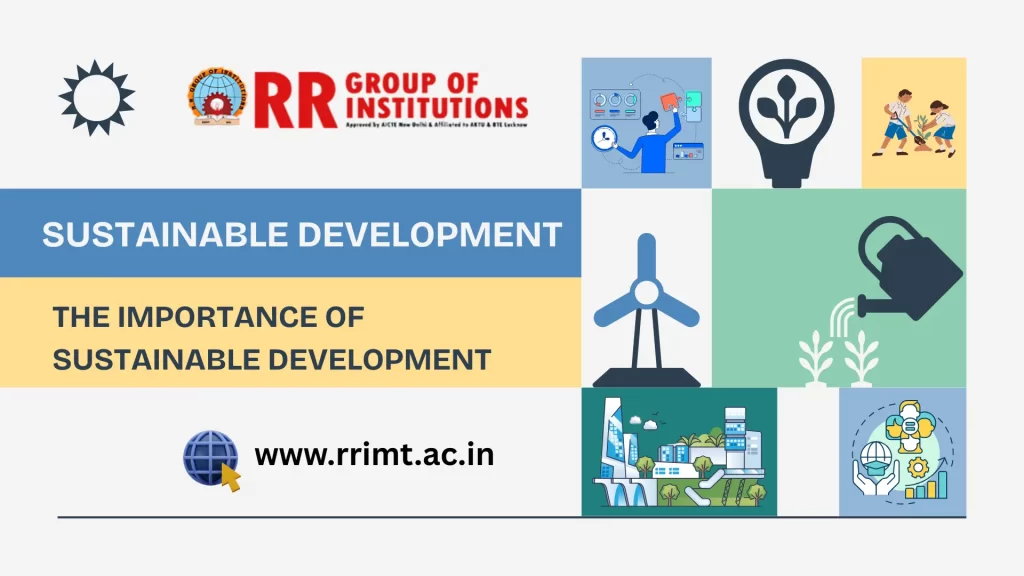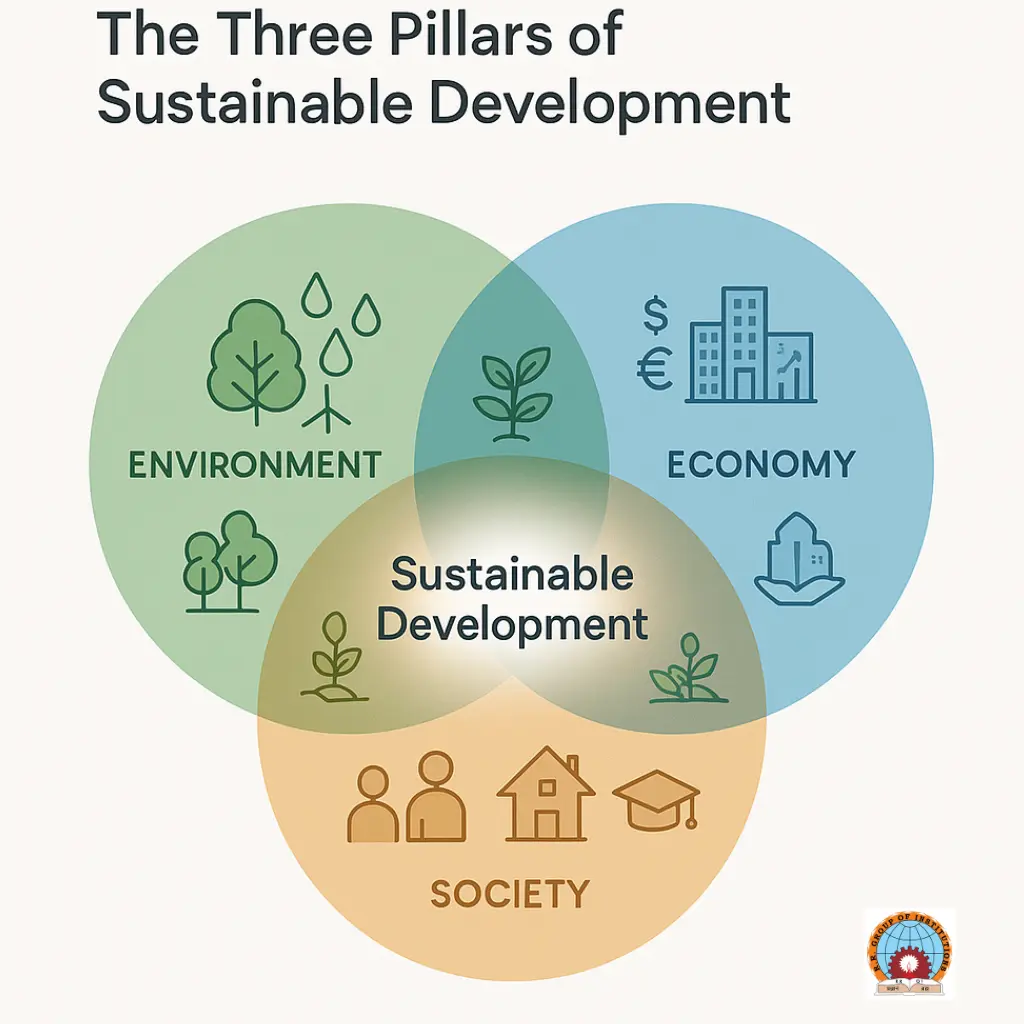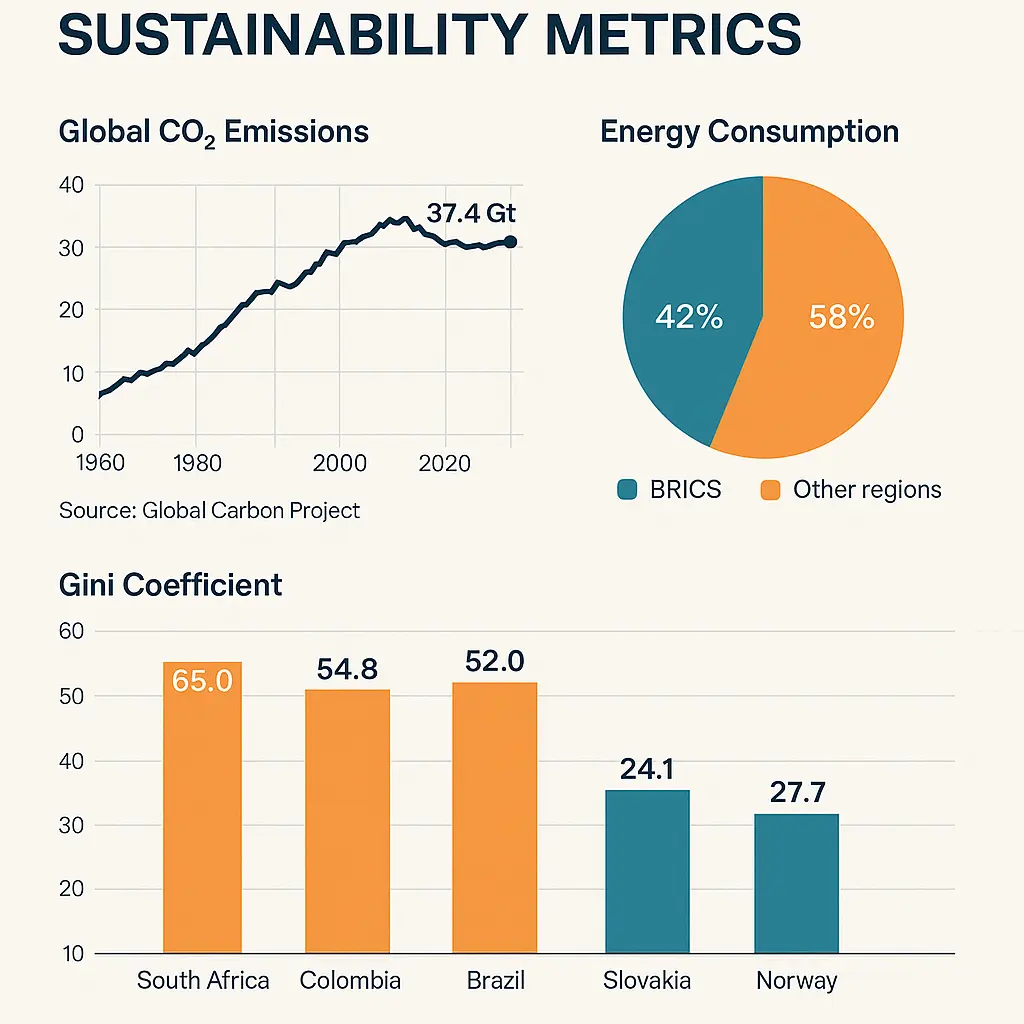
Sustainable Development is a method of boosting and growing our societies that ensures we meet our current basic needs without compromising the ability of future generations to meet theirs. Imagine it as a balancing act where we strive to create a better world today while also protecting the planet for tomorrow. Worries about climate change, resource depletion, and global inequities in today’s world have especially heightened the prioritization for sustainable development. With the looming problem on how to foster economic growth while preserving the environment and aiding social progression, sustainable development offers a resolution that bridges these often conflicting priorities.
Sustainable development is a formwork for addressing current needs while considering the future needs of generations to come. It seeks to balance social, economic, and environmental factors to create a society where resources and living conditions meet human needs without compromising planetary health.
Understanding Sustainable Development
Modern societal structure depends on a complex system of economic development, environmental exploitation, and social advancement. Nonetheless, there is a new challenge in balancing the consumption and preserving of resources as the economy develops and the population increases. Sustainable development is geetings the needs of the present generation while enabling other future generations to meet their basic needs.
“Meeting the Needs of Future Generations” is an article published in 1987 by the United Nations with the Brundtland Report as its title. This document stressed that any development initiatives should include ecological integrity, social equity, and economic prosperity as three of the key pillars. As highlighted in this definition, there must be a balance of social and economic equity which is achieved through sustainable growth without causing damage to the environment. The meaning is targeting the balance of the three pillar lines—people, planet, and profit.
Important Features of Sustainable Development:
- Economic Development: Sustainable development supports equitable and inclusive economic advancement, avoiding exploitation while providing a decent standard of living for all.
- Social Equity: Social equity is addressed by making sure that every social need which includes education, health care, and decent work, is accessible to all individuals.
- Environmental Protection: Rather, sustainable development acknowledges the use and protection of the environment and natural resources for both the present and future generations.
- Intergenerational Equity: Emphasizes the resources and opportunities available today should also be accessible to future generations.
Illustration of Sustainable Development:
- Renewable Energy: Utilization of solar, wind, and other renewable energy sources decreases pollution as well as reliance on fossil fuels.
- Sustainable Agriculture: Use of crop rotation to improve soil fertility and decrease the need for chemical fertilizers.
- Urban planning: Creation of cities that support walking and biking while providing access to green space, which in turn decreases public transport emissions.
- Social protection programs: Provision of a basic standard of living for all through the implementation of social protection programs such as unemployment benefits and healthcare services.
The Brundtland Report and the sustainable development goals (SDGs):
Defined in the Brundtland report published in 1987, sustainable development catalyzed the attempt to create a balance between economic growth, social welfare, and environmental conservation. In 2015, the United Nations adopted a set of 17 Sustainable Development Goals (SDGs) https://sdgs.un.org/goals that serve as a guideline to achieve sustainable development on a global scale: the eradication of poverty, tackling hunger, climate change, inequality, and others.
The Importance of Sustainable Development
To foster sustainable development, one needs to examine the impact of climate change, depletion of resources, and social inequality. Sustainable practices today will secure a better tomorrow for all. Each of the following essential points is broken down as follows:
- Environmental Protection: The impacts of climate change in the form of severe weather conditions and loss of biodiversity provide a direct threat to humanity, which makes the adoption of sustainable development policies critical. Sustainable development allows policies to be created and amended that promote sustainable development.
- Economic Stability: Circular economies, ecological services, and renewable energy sources drive the economy in the long run. Sustainable development prioritizes circular economy models and ecological services, creating further job opportunities which leads to economic stability.
- Social Equity: Sustainable development highlights the link between environmental degradation, poverty, and inequality, as well as social imbalance. Providing improved access to quality education, healthcare, and employment design will help marginalized communities.
- Global Cooperation: Unlike these initiatives, sustainable development goals are not confined to specific nations. Problems like pollution and climate change are not bound to certain regions which makes them a worldwide issue, thus necessitating collaborative and unified policies for the sustenance of all life.
- Future Generations: Perhaps most importantly, sustainable development enhances how future people will inherit a world where their development is possible. This ensures that resource use and industrial growth does not compromise the outlook for the future.
To phrase it differently, sustainable development marries ecological protection, social welfare, and economic prosperity and achieves this in a just and enduring way. Achieving this is no easy feat, but it is critical to preserving the environments, health, and capabilities of people in the future.
Key Pillars of Sustainable Development
Although sustainability spans a broad range of concepts and actions, it is often conceptualized through three major pillars:
- Economic Sustainability
- Environmental Sustainability
- Social Sustainability
These pillars form the core of the triple bottom line, a widely recognized framework in both public and private sectors for measuring progress.

Economic Sustainability
Economic Sustainability outlines frameworks that create systems where wealth can be generated and prosperity achieved while considering nature’s ecological boundaries and social harm. While conventional economic models concentrate on growth and consumption, Evergreen economies emphasize:
- Resource Efficiency: ensuring access to needed materials.
- Equitable Sharing: Policies enabling fair allocation of wealth for both the Global North and South.
- Innovation for Longer-Term Growth: Reinvesting proceeds in research and technology for the ever growing need for renewable energy sources, green technologies, and better recycling to mitigate finite resource reliance.
- Circular Economy: Transforming linear economies from “take-make-dispose” to closed-loop systems where goods are re-used perpetually.
These methods are being implemented by companies all over: automotive, consumer electronics, and fashion. The outcome is less waste and pollution, decreased operational cost, improving brand reputation, and enhanced customer demand.
Environmental Sustainability
Water, electricity, lumber, and fossil fuels all qualify as modern resources which are greatly consumed. The modern approach towards environmentalism focuses on preserving the health of the ecosystem and biodiversity by curtailing pollution and mismanagement of resources. The objectives of environmental sustainability include:
- Use of Renewable Resources: Use of solar, wind, geothermal, and hydro power in place of fossil fuels support this objective alongside increasing energy efficiency in industries and households.
- Ecosystem Balance: To secure food in the future, habitats and endangered species must be preserved.
- Adaptation to Climatic Changes: Due to the current state of the planet, one must prepare agriculture, infrastructure, and social systems to cope with the extremes in weather while accommodating for rising sea levels.
- Responsible Food Production: Fisheries must embrace organic farming while permaculture in order to sustainably provide food without harming the environment.
Environmental issues such as pollution and resource mismanagement are only a part of the larger issue of public health, social and economic inequality, and conflict. These issues alongside destroy the global poverty alleviation efforts and allow for the faster spread of disease.
Social Sustainability
As much as the media pays attention to the economic or environmental concerns because of the business world and the ever-pressing climate change, the social aspect of sustainability is extremely important for the working of a well functioning society. It means: building up communities that are rightly just, inclusive, cohesive, and respecting human rights and personal wellbeing. The essential features of social sustainability are as follows:
- Health & Education: A wide access to healthcare and education encourages the development of human capital, drives innovation, breaks poverty cycles.
- Equity and Inclusivity Combating racism discrimination of any form of gender and economic status fostering the equality of the access to the resources and opportunity to avail them to a better chance of life economy.
- Community Resilience: Supporting stronger social networks increases the ability of the community to adapt to a crisis whether it’s an economic downturn or a natural disaster.
- Cultural Preservation: Acknowledging Diversity in Culture and celebrating it gives people who belong to certain ethnic groups rights over their lands and resources.
Having social sustainability as their goal, initiatives transform societies into fair, safe spaces, and strive for equity starting from local grassroots movements up to global philanthropic undertakings.
Approaches and Strategies for Achieving Sustainable Development
Achieving a more sustainable world requires a spectrum of approaches. Below are some effective strategies that government bodies, businesses, and communities have adopted:
1.Policy and Governance:
- Green Regulations: Governments are enforcing policies such as carbon taxes and emissions trading schemes to environmentally motivate industries to shift towards adopting cleaner operational processes.
- Sustainable Development Goals (SDGs): In 2015, the United Nations adopted the 17 SDGs which collectively aim at solving issues such as poverty, inequality, and climate change on a global scale.
- Local Action Plans: Local governments such as provinces, cities, and municipalities define particular goals for reducing waste, increasing adoption of renewables, and enhancing infrastructure.
2.Corporate Social Responsibility (CSR):
- Sustainable Business Practices: Businesses check their entire supply chain operation to confirm that the raw materials are acquired responsibly, there is no exploitation of workers, and ecological harm is limited.
- ESG Reporting: Nowadays, moreover , for the sake of trust and transparency, particularly among consumers and investors, companies increasingly disclose their sustainability performance through Environmental, Social, and Governance (ESG) reporting frameworks.
- Green Innovation: Corporate Research and Development (R&D) is focused on addressing sustainability issues through the development of eco-friendly technological innovations such as solar panels, energy-saving devices, and even biodegradable packaging which help in reducing carbon footprints.
3.Public-Private Partnerships:
- Cooperative Innovations: Public sector and private company joint funding can initiate massive renewable energy projects or transform public transport into more eco-friendly systems.
- Community-Initiated Projects: Non-governmental organizations along with businesses and grassroots movements join forces for the implementation of urban farming, reforestation, and the preservation of water resources.
4.Educational and Awareness Campaigns:
- Sustainability Education: Integrating sustainable practices into the school curriculum from an early age helps shape future generations into eco-conscious individuals.
- Public Outreach: Media campaigns educate the masses on the need to embrace sustainable practices, triggering changes in waste management, plastic use, consumption, and overall responsible behavior.
5.Technological Innovations:
- Clean Energy: The shift toward renewable power sources is facilitated by the increasing efficiency of wind turbines, as well as solar panel and battery storage technology.
- Smart Cities: Cities that combine effective architecture and urban planning with the Internet of Things (IoT) and other emerging technologies are capable of optimizing even the traffic and energy consumption.
- Sustainable Agriculture: The data-driven precision farming of the technology economy reduces chemical inputs while increasing crop yields.
These approaches highlight the truly sustainable development in identifying systems in which every community, region, and country may need different solutions based on natural resources, socio-economic structure, and culture.

Global Examples of Sustainable Development Initiatives
Sustainable development is not merely a theoretical notion; it is actively underway in many countries throughout the world. A few notable examples are:
1.Denmark’s Renewable Energy Revolution
- Denmark leads the globe in energy saving technologies and the utilization of wind power. The Danish Energy Agency says that the country frequently exceeds its wind energy usage. This reduces carbon emissions while also stabilizing energy costs.
2.Costa Rica’s Green Model
- Costa Rica, a country with a strategic vision towards the environment, generates over 99% of its electricity from renewable sources including hydro, geothermal, wind, and solar energy. Additionally, its National Decarbonization Plan aims at achieving complete elimination of fossil fuel usage by 2050.
3.Germany’s Energiewende
- To inspire a shift away from nuclear energy, Germany’s Energiewende—energy transition—offers guidelines, incentives, and public involvement in renewable energy. The country, as Europe’s clean energy innovation leader, continues to face numerous challenges.
4.Rwanda’s Focus on Social Sustainability
- Post-genocide Rwanda has put effort into social sustainability in the form of reconciliation and poverty alleviation. These efforts include extensive healthcare and education investments, accompanied by environmentally friendly policies such as the prohibition of plastic bags.
5.Singapore’s Water Management
- Through the use of wastewater recycling, desalination, and rainwater harvesting, Singapore has positioned itself as a leader in water technology even with its limited natural resources. The integrated system managed by Singapore’s National Water Agency, PUB, stands as a testament to innovation overcoming scarcity.
Analyzing these initiatives reveals the interlinked nature of sustainable development. It illustrates the importance of a government’s commitment to strong funding, technological advancement, and active community participation.
The Future of Sustainable Development
Looking ahead, sustainable development remains an evolving practice shaped by cutting-edge research, global policy shifts, and technological breakthroughs. The following trends are expected to affect its future::
- Green Infrastructure Growth: With climate challenges mounting, governments are expected to heavily invest in resilient infrastructure—such as flood defenses, drought-resistant agriculture, and wildlife corridors.
- Transition to a Green Economy: Economics experts highlight the growth potential in renewable energy markets, low-carbon industries, and sustainable entrepreneurship—all of which can generate new jobs and avenues of prosperity.
- Global Policy Collaboration: Multilateral discussions under frameworks like the Paris Agreement will be crucial to limiting global temperature rise and advancing sustainability goals.
- Technological Disruption: Breakthroughs in artificial intelligence (AI), biotechnology, and advanced materials could drastically reduce carbon footprints, resource usage, and waste.
- Rising Awareness: Education and activism—particularly by younger generations—underscore a shift in societal values toward minimal-impact living.
Experts highlight that each stakeholder—from individuals to multinational corporations—bears responsibility for ushering in a sustainable future. While policy frameworks like the UN Sustainable Development Goals (SDGs) provide general direction, proactive and adaptive approaches at the local level are essential for real transformation.
Conclusion: sustainable development
The importance of “sustainable development” goes far beyond combating climate change or preserving biological diversity; it integrates approaches that safeguard the health of the environment, the economy, and society for future generations. As we have seen, sustainability encompasses three key areas: economics, environment, and society. Together, these pillars enable us to address both global and local issues in a more holistic manner. In this way, we can foster balanced solutions that benefit present and future generations.
We can advance towards sustainable development by formulating innovative policies, stimulating responsible corporate practices, and facilitating community-driven development. Governments, businesses, and grassroots organizations that collaborate on approaches increase the likelihood of ensuring our grandchildren inherit a sustainable planet and abundant opportunities to thrive. Achieving sustainability may present challenges; however, the rewards of a resilient system ultimately fuel the endeavor, paving the way for long-term, equitable progress.

